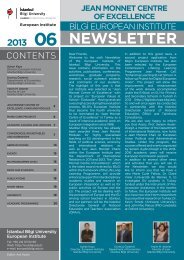WP2 Turkey: Country Report - İstanbul Bilgi Üniversitesi | AB Enstitüsü
WP2 Turkey: Country Report - İstanbul Bilgi Üniversitesi | AB Enstitüsü
WP2 Turkey: Country Report - İstanbul Bilgi Üniversitesi | AB Enstitüsü
Create successful ePaper yourself
Turn your PDF publications into a flip-book with our unique Google optimized e-Paper software.
Social Impact of Emigration and Rural-Urban Migration in Central and Eastern Europe<br />
VT/2010/001<br />
Roma mostly work as musicians in show-business, or in night-clubs and restaurants.<br />
Moreover, street jobs constitute the most recurrent activities for them as well as ambulatory<br />
street vending (fruits and vegetables differing according to season, bottles of water, music<br />
tapes, toys, everyday accessories and gadgets, bus tickets; prepared meals, especially<br />
stuffed mussels, and rice with chicken, etc.); collecting used paper, cardboard, and cans for<br />
recycling; shoe-shining; weighing people, etc. In these conditions, although more than one<br />
member of the households are working, the income generated by each is so low that the<br />
overall household income remains low.<br />
Some of the members of the Roma population travel across the country. They are mainly<br />
residing in the eastern parts of the country and they are engaged in stock raising through a<br />
constant process of migration in accordance with the seasonal conditions. Roma population<br />
residing in Thrace is manly engaged in agricultural sector. Some of the Roma communities<br />
migrate from the east and the south eastern for seasonal works in the northern parts of the<br />
country in order to do work in harvesting nuts, tobacco, and tea. Fruit and vegetable picking,<br />
and other cash crops are a mainstay form of income for many groups in <strong>Turkey</strong>, and<br />
especially Roma who rely upon this for the substantial part of their annual income. The daily<br />
rates of those labouring in the fields are extremely low; and they work in very poor conditions<br />
(Uzpeder et al., 2008).<br />
One of the most debated issues recently is the impact of the so-called urban gentrification<br />
schemes on the Roma communities. Sulukule is a great example in this sense. Sulukule is a<br />
very historical district around the Byzantian City Walls surrounding the inner city of Istanbul.<br />
It is estimated that Roma community of Sulukule is the first settled community of Roma<br />
outside India dating back at least 1,000 years. Roma have traditionally eked out a living in a<br />
close-knit environment rendered all the more intimate by Sulukule’s network of low-rise<br />
houses. Now Turkish Public Housing Enterprise 21 (TOKI, Turkish version of French<br />
habitation à loyer modéré, HML) is building several new four-storey blocks as well as 620<br />
modern villas, a hotel and facelifts for 45 listed Ottoman houses. Sulukule’s 503<br />
homeowners have been offered the new houses at discount prices by the local Fatih<br />
municipality, which is running the regeneration project along with the city council. But the<br />
Sulukule Platform, a protest group fighting to save the district’s heritage, says few residents<br />
can afford it (http://sulukulegunlugu.blogspot.com). “Most of [the Roma people] suffer from<br />
poverty and hunger. A history has been eradicated. Now, TOKI is building deluxe residences<br />
in Sulukule,” said Hacer Fogo, a member of the Sulukule Platform, who called on the institute<br />
to devote more effort to addressing issues faced by people living on the historic peninsula,<br />
rather than prioritizing the histories of its mosques and artifacts (Personal interview with<br />
Hacer Fogo, 15 March 2011).<br />
5.4. Other Ethnic and Religious Vulnerable Communities<br />
The ECRI report of the Council of Europe addresses at the Alevis, Kurds, Assyrians,<br />
Armenians, Greeks, Jews and Roma as the most vulnerable groups in <strong>Turkey</strong> (ECRI, 2011).<br />
As Kurds and Roma were already discussed in detail, this section will concentrate on the<br />
other groups namely Armenians, Assyrians, Alevis, Arabs, Balkan and Caucasian Muslims.<br />
Most of the non-Muslim populations either reside in Istanbul, or already emigrated abroad as<br />
their original homeland became insecure for them to survive. Gradual emigration of various<br />
ethno-cultural and religious minorities to European countries has also impacted the ones<br />
who stayed behind. Those who could not migrate abroad because of the lack of sufficient<br />
economic and social capital migrated to the big cities such as Istanbul in order to protect<br />
themselves from the ethnic, cultural and religious pressure in the rural space. It is quite<br />
common to see various groups of Armenians, Assyrians, and Alevis who followed this<br />
pattern.<br />
21 See http://www.toki.gov.tr/, accessed on 10 August 2011.<br />
Final <strong>Country</strong> <strong>Report</strong> <strong>Turkey</strong> 22



